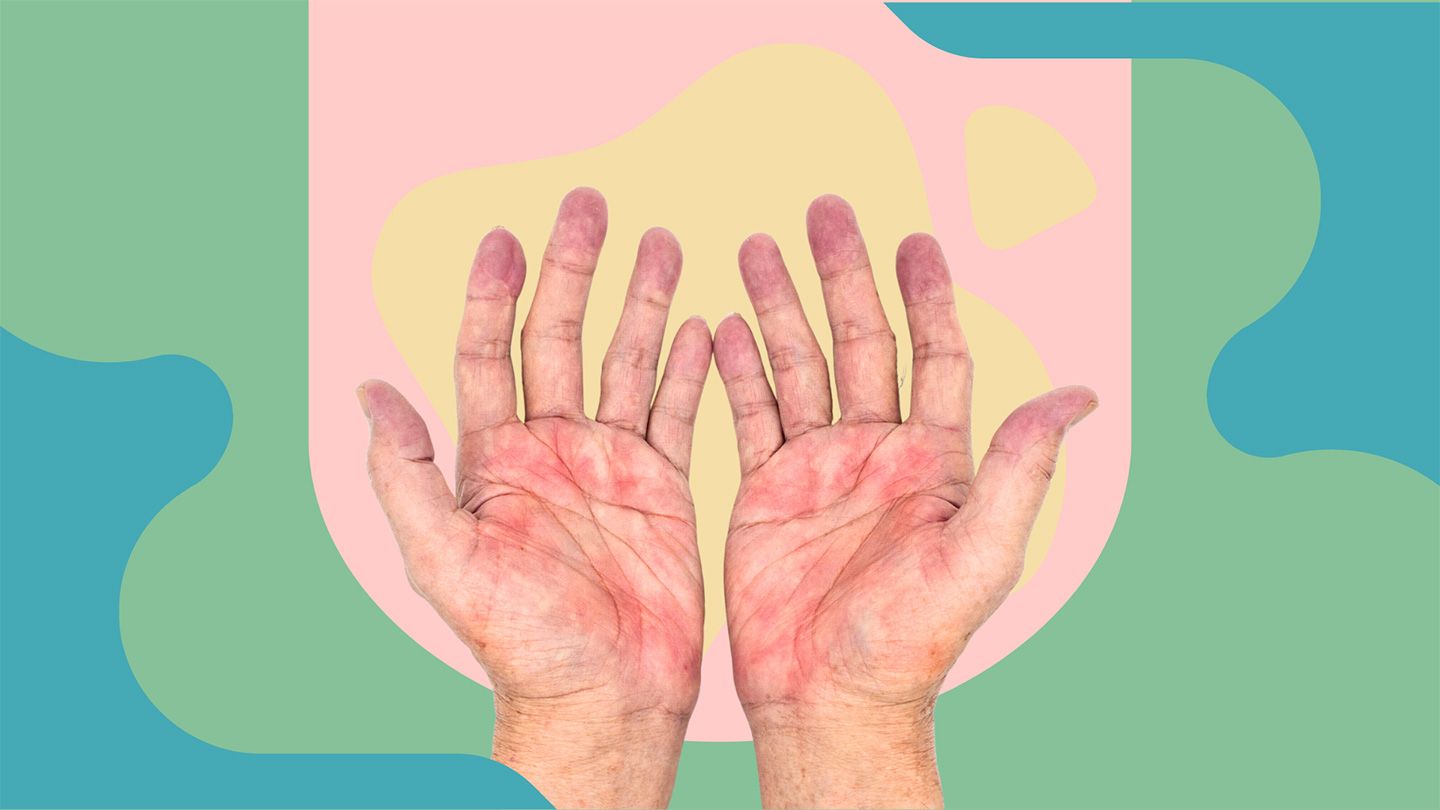Rheumatoid arthritis (RA) is a chronic inflammatory disease that primarily affects the joints, but it can impact other organs and systems in the body, including the skin. For many people with RA, its effects include rashes in different areas of the skin. In some cases, skin rashes are related to RA or RA treatments, but some skin issues aren’t connected to arthritis at all. Keep reading to find out more about what rashes can occur when you have rheumatoid arthritis, what symptoms to look for, and when to see your doctor.
What Is a Rash in RA? What Is an RA Rash? “There are different types of rashes that can occur in association with rheumatoid arthritis,” says Jonathan Greer, MD , a rheumatologist at Arthritis and Rheumatology Associates of Palm Beach in Florida. There isn’t one specific “RA rash,” but rather various associated skin issues, says John M. Davis III, MD , a rheumatologist at the Mayo Clinic in Rochester, Minnesota. These rashes can be papules, pustules, plaques, or ulcers — but they should not be confused with rheumatoid nodules , which are palpable, firm nodules under the skin that may or may not turn into an ulcer, says Dr. Davis. Although sometimes rashes can be a superficial and short-lived reaction, in the case of RA, they can sometimes be a sign of uncontrolled disease or more serious complications.
Rheumatoid Vasculitis Rheumatoid Vasculitis Rheumatoid vasculitis is one of the more serious rashes that people with RA can get, says Dr. Greer. “Vasculitis is inflammation of the small blood vessels in the skin,” he says. Rheumatoid vasculitis affects people who have had RA for at least 10 years.e60dc2a1-f33c-4a05-9b50-8e3e8e5976298766c9bb-914f-4d55-9927-d136e8cfc5c7 The rash can present in a variety of ways, says Greer. “It can be red or purplish spots, or little pinpoint red dots on the skin, and it can be very itchy,” he says. It usually appears on or around the fingers, hands, feet, and toes.e60dc2a1-f33c-4a05-9b50-8e3e8e5976298766c9bb-914f-4d55-9927-d136e8cfc5c7 Rheumatoid vasculitis can cause severe complications if it isn’t diagnosed and treated. This can include skin ulcers, gangrene (when body tissue dies due to a lack of blood supply), heart attack, and stroke.e60dc2a1-f33c-4a05-9b50-8e3e8e5976298766c9bb-914f-4d55-9927-d136e8cfc5c7 “Typically, people who have rheumatoid vasculitis have very active disease that is not well controlled and blood tests that are strongly positive for rheumatoid factor ,” says Greer. It’s not clear why some people with RA develop rheumatoid vasculitis, but smoking, male sex, and other systemic manifestations, such as rheumatoid nodules, lung disease, and scleritis (an inflammatory condition that affects the white part of the eye) are risk factors, says Davis.
Neutrophilic Dermatoses Neutrophilic Dermatoses Neutrophilic dermatoses are a group of inflammatory skin conditions in which the immune system is overactive, and white blood cells called neutrophils are dysregulated.e60dc2a1-f33c-4a05-9b50-8e3e8e59762934fdbc59-6766-4659-b5da-4eaa4599319c There are several types of neutrophilic dermatoses that may develop in people with RA. Sweet Syndrome This rash typically consists of tender papules (small, solid raised bumps), that may enlarge to form plaques or blisters. It can be painful and burning, but is not itchy. The rash most often appears on the face, neck, arms, and hands. People with Sweet syndrome may also have a fever , joint pain, and malaise.e60dc2a1-f33c-4a05-9b50-8e3e8e59762934fdbc59-6766-4659-b5da-4eaa4599319c Pyoderma Gangrenosum There are many variants of pyoderma gangrenosum, a painful skin condition that causes large, painful sores on the skin, usually on the legs. It usually starts with a small bump on the skin (it can look like a spider bite), but within days it can evolve to form shallow or painful deep ulcers, which can expose underlying tendons or muscle. It’s not an infection (though it can turn into one), and it usually clears up with treatment, though it can result in scarring or skin discoloration.e60dc2a1-f33c-4a05-9b50-8e3e8e5976291f63cbf1-a498-485c-980c-8f92c24ad34f Rheumatoid Neutrophilic Dermatitis This type of rare rash occurs most often in middle-aged women with severe RA. It usually looks like red, raised papules, plaques, nodules, or blisters that are tender and painful but not itchy. The lesions are most often found on the hands, arms, feet, legs, neck, and trunk.e60dc2a1-f33c-4a05-9b50-8e3e8e59762934fdbc59-6766-4659-b5da-4eaa4599319c Palisaded Neutrophilic Granulomatous Dermatitis (PNGD) and Interstitial Granulomatous Dermatitis (IGD) Sometimes these two conditions are put together under the term “reactive granulomatous dermatitis.” PNGD can look like raised bumps that are depressed in the middle and are usually found on the extremities, especially the elbows and fingers. In IGD, the rash looks like ring-shaped plaques or rope-like cords that appear on the sides of the torso and skin folds of the trunk.e60dc2a1-f33c-4a05-9b50-8e3e8e59762934fdbc59-6766-4659-b5da-4eaa4599319c
Felty Syndrome Felty Syndrome Also known Chauffard-Still-Felty disease, this is a rare condition in which a person has RA, neutropenia (in which the body has low levels of neutrophils, a type of white blood cell), and splenomegaly, a condition in which the spleen is larger than normal. It occurs in 1 to 3 percent of people with RA, and mostly in women. People with Felty syndrome may have skin ulcers (sores), especially on the legs, and signs of bleeding under the skin. There can also be patches of abnormally colored skin.e60dc2a1-f33c-4a05-9b50-8e3e8e5976299bb876a9-68a1-494e-84e0-ff3a05dc8b20
Palmar Erythema Palmar Erythema Palmar erythema is redness of the palms. Although it’s not itchy or painful, it may look like a rash. Although palmar erythema commonly occurs in people with RA, it’s not specifically related to it, says Davis. “It also occurs in other systemic conditions such as liver cirrhosis , thyrotoxicosis, diabetes mellitus, and during pregnancy, among others,” he says. Because the nerves and muscles in the hands require good blood circulation, conditions that may impact that — including rheumatoid arthritis — could cause the color in your palms to change.e60dc2a1-f33c-4a05-9b50-8e3e8e59762956307220-7e73-4f13-a406-d04ab85f1afb
RA Rashes Caused by Drug Reactions Drug Reactions There are many RA medications that can cause psoriasis -like eruptions or other rashes, says Davis. “The most notable for causing rashes are TNF inhibitors, hydroxychloroquine, and sulfasalazine, but any drug can be an offending agent,” he says. Tumor necrosis factor (TNF) is a protein in your body that causes inflammation, and TNF inhibitors are drugs that stop inflammation. They’re used to treat inflammatory conditions, including rheumatoid arthritis. TNF inhibitors can be used by themselves or in combination with other medications.e60dc2a1-f33c-4a05-9b50-8e3e8e59762939ecc372-2a26-4762-9d25-1d3aa15deb5b Hydroxychloroquine and sulfasalazine are disease-modifying drugs that calm the immune response and reduce inflammation. “Typically, people develop a hives -like red rash that’s very itchy and all over the body. It usually happens within a day or two after they take the medication, and so it’s usually pretty easy to diagnose,” says Greer.
Hives Hives People with RA can develop hives — red, raised welts that itch — that are unrelated to a medication, says Greer. “It’s also called urticaria, and that can occur as part of the immune system’s response to having rheumatoid arthritis,” he says.
Non-RA Related Rashes Such as Eczema, Psoriasis, or an Infection Non-RA Rashes People with RA can also have rashes that are caused by other conditions that affect the skin, including eczema , psoriasis, or an infection, says Davis. Eczema On dark skin, an eczema rash can look purple, brown, or gray, and on a light skin tone, it looks pink, red, or purple. Research suggests that people with atopic dermatitis (the most common form of eczema) are more likely to develop RA than the general population, but people with RA don’t have a higher risk of developing eczema than the average person.e60dc2a1-f33c-4a05-9b50-8e3e8e5976295aec1bbb-be17-4c2d-9617-39cb1567dbf2 Psoriasis Although it’s possible that a person with RA could have psoriasis, psoriasis is associated with a type of arthritis called psoriatic arthritis , says Greer. The most common type of psoriasis causes thick, raised areas of skin known as plaques. “So if a person with arthritis also had psoriasis, we would want to make sure that they don’t have psoriatic arthritis instead of rheumatoid arthritis ,” he says. Infection Germs sometimes enter a rash and cause an infection. Signs that a rash is infected might include pus, yellow or golden crusts, pain, swelling, warmth, or an unpleasant odor. The skin around an infection might look red, purple, or brown. You might also have systemic symptoms such as swollen lymph nodes or a fever.e60dc2a1-f33c-4a05-9b50-8e3e8e597629b2b6084d-6291-4e79-9e68-a78f5e08cded
When to Seek Medical Care for a Rash When to Seek Medical Care People with rheumatoid arthritis who develop rashes that are new, abnormal, and persistent should see their physicians, including their rheumatologist, to determine if some change in RA management is needed, says Davis. A rheumatoid rash is often a sign that RA is not being appropriately managed, says Greer. “To reduce the likelihood of an RA rash, it’s vitally important that the rheumatoid disease gets under control,” he says. “If it’s suspected that the rash is caused by medication, the first step is to hold or stop the medication. Often, the next step is a dermatology consultation for possible skin biopsy,” Davis says. Treatment with medications like antihistamines or sometimes oral glucocorticoids may be indicated to relieve symptoms of the rash, says Davis. “Rashes that are painful, spreading, or causing ulcers are potentially more serious and require more urgent attention,” he says. If you have a high fever with the rash, it’s important to seek medical attention right away.e60dc2a1-f33c-4a05-9b50-8e3e8e597629fc4c8eb5-8013-4931-afa7-5f117ec3f41b
The Takeaway Rheumatoid arthritis (RA) rashes may be a sign of uncontrolled disease or complications. Rashes caused by conditions such as rheumatoid vasculitis can lead to severe complications if left untreated. Persistent, painful, or spreading rashes should be evaluated by a doctor.
Read the full article here
Leave a comment




